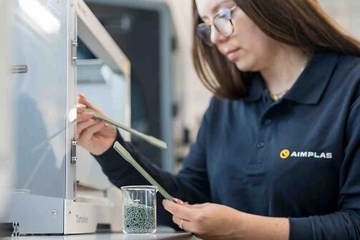FOOTWEAR
Aimplas develops 3D-printing material from scrap shoe leather
— By Plasteurope.com correspondent —
 Leather scraps from Spain’s shoe production are being repurposed into new soles and heels (Photo: Aimplas) |
Spanish plastics technology organisation, Aimplas (Valencia; www.aimplas.net), is helping bring circularity to local shoe manufacturers by developing a 3D-printing material made from leather scraps discarded during the manufacture of millions of pairs across the country.
The resulting filament material will be used to produce soles and heels for new shoes, said Aimplas, which is working on the reclamation project as part of a consortium comprising Spanish footwear brand Pikolinos (Alicante; www.pikolinos.com), the Arnedo-based Footwear Technology Centre of La Rioja (www.ctcr.es), and polymer producer Evatalking (Alicante; www.eva-talking.com).
Related: Aimplas investigates algae-to-plastics potential
According to Aimplas, the Valencian Community is responsible for 65% of Spanish shoe production, or 70 mn pairs per year. The waste generated by footwear factories in leather scraps amounts to around 3,500 t/y, much of which is sent to landfills.
“Although there are different recycling techniques, their application for complex waste such as footwear is not easy for diverse reasons, including the presence of substances such as adhesives and inks. This waste cannot be recycled, and even if it can be, the resulting recycled material is of low quality,” it added.
For the waste leather to be used as a filament for 3D printing, the particle size of the scraps has to be reduced to 10 µm. “The project’s aim is to combine different percentages of micronised leather with various polymers whose mechanical properties make them suitable for footwear for working with leather,” Aimplas said.
The resulting filament material will be used to produce soles and heels for new shoes, said Aimplas, which is working on the reclamation project as part of a consortium comprising Spanish footwear brand Pikolinos (Alicante; www.pikolinos.com), the Arnedo-based Footwear Technology Centre of La Rioja (www.ctcr.es), and polymer producer Evatalking (Alicante; www.eva-talking.com).
Related: Aimplas investigates algae-to-plastics potential
According to Aimplas, the Valencian Community is responsible for 65% of Spanish shoe production, or 70 mn pairs per year. The waste generated by footwear factories in leather scraps amounts to around 3,500 t/y, much of which is sent to landfills.
“Although there are different recycling techniques, their application for complex waste such as footwear is not easy for diverse reasons, including the presence of substances such as adhesives and inks. This waste cannot be recycled, and even if it can be, the resulting recycled material is of low quality,” it added.
For the waste leather to be used as a filament for 3D printing, the particle size of the scraps has to be reduced to 10 µm. “The project’s aim is to combine different percentages of micronised leather with various polymers whose mechanical properties make them suitable for footwear for working with leather,” Aimplas said.
29.11.2024 Plasteurope.com [256676-0]
Published on 29.11.2024
